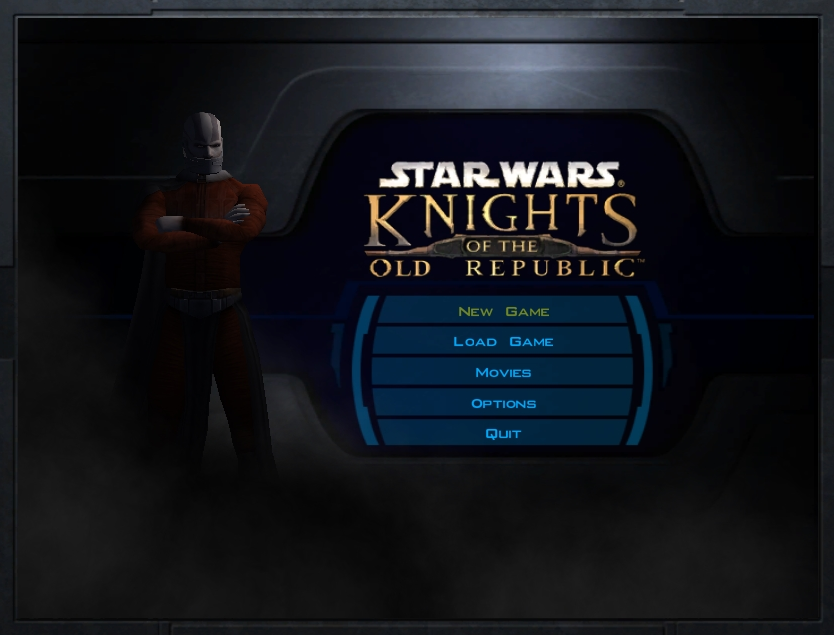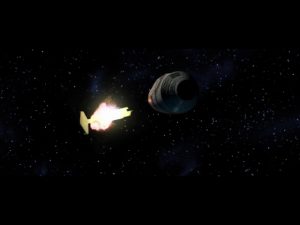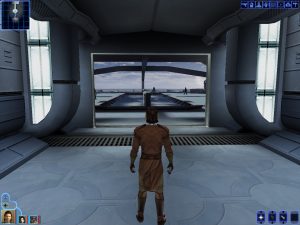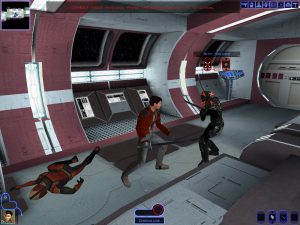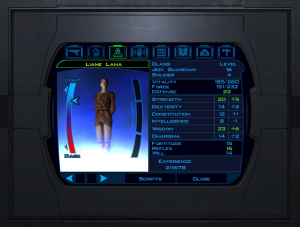It is a good time for the Force to be with you. Episode VII The Force Awakens has blown satisfying new life into the movie franchise, blotting Jar-Jar-infested prequels out of our memories. Equally, the progress that Apeiron is making on a reboot of the original go-to Star Wars gaming experience, 2003 Bioware-epic Knights of the Old Republic (KOTOR), has this Padawan dancing little jigs in his living room.
To be sure, rumours of an official KOTOR re-release are never far away, which, if realised, may take the wind from Apeiron’s sails. And the usual disclaimer applies to crowdsourced projects – there is no guarantee that KOTOR: Apeiron will come to fruition, or that it won’t find legal hurdles thrown up by franchise-owners as it marches down the long road to completion.
Yet we may hope that progress is swift and unobstructed. While there is not much to go on at this stage – little is known about the ‘new worlds, missions, HUD, inventory, items, and companions’ Apeiron promises – the project images appearing on Apeiron’s Twitter page, showing off beloved, visually stunning environments in an updated game engine, merit excitement. (Will Sleheyron, the lava world cut from the original, finally make an appearance?)
But for the hype building around KOTOR 2.0, let’s pause for a moment. Can a re-release realistically live up to the expectations inspired by the demi-mythical status of the original? Will a visual dusting off and repackaging do the trick, or has time eaten away at the appeal of KOTOR’s fundamentals, making what once shone now bland? To put it bluntly – is Apeiron’s effort a fool’s errand?
The surest way to find out, one would think, is to dive back into the original KOTOR and identify what has aged and what is timeless, what holds up and what crashes down, hoping to pinpoint necessary tweaks to return a matte KOTOR-gem back into a lushly shining jewel. Having embarked on precisely this mission, you can find the report below.
—
Long, Long, Long Ago – Even Longer than Usual – In a Galaxy Far Away…
To refresh rusty memories, and for those too young (bless you!) to have played the game when first released, the Knights of the Old Republic premise is as follows. Set some 4000 years before the original trilogy, KOTOR’s opening salvo deposits the player in the middle of a galactic fleet battle. As so often, the ancient Republic’s battleships are locked in combat with their Sith counterparts in a confrontation for mastery of the known universe. On board a mid-sized Republic cruiser called the Endar Spire, a gifted Jedi by the name of Bastila attempts to single-handedly turn the odds against the numerically superior Sith through her special Battle Meditation technique, which is capable of dispiriting the minds of men. However, hope of success fades when the Endar Spire is struck and boarded by Sith troopers, prompting a frenetic scramble for the escape pods seconds before the limping vessel explodes in a ball of flames.
After this eleventh-hour getaway, the escape pods crash down on Taris, a nearby cityscape planet in the style of Coruscant. A weakened Bastila is found and taken prisoner by local thugs. This, paradoxically, is a very good thing. Taris is under Sith occupation, and troopers are scouring every inch of its surface in a bid to locate and capture the powerful Jedi. The Sith are, however, hesitant to press into the outlaw-dominated, unpredictable underworld. The player’s initial sole ally in their objective of freeing Bastila from gang clutches and escaping the planet whole is Carth Onasi, a Republic war hero who is highly suspicious of your presence on the Endar Spire – one which you yourself struggle to explain. Soon, the meandering search for Bastila sets in motion events that rapidly catapult your character to the centre of the epic struggle between the Sith’s imperialistic ambition and the skeletal Jedi Order’s self-assigned mission to thwart it.
KOTOR’s script that guides you through the adventure has aged little – does good writing ever, really? – and feels as rich and emotive as it did back in 2003. Offering a timeless ‘Oh, snap!’-experience outstandingly rewarding to first-timers, it is easily the game’s driving force. The story is served up through periodic revelations as the player tours from planet to planet searching for (rather poorly) concealed artefacts, and KOTOR preserves an air of mystery about where it came from and where it is going. As the master quest unfolds, identity titbits of the mythical yet somehow centre-stage ‘Builders’ are revealed, and critically, of your own background as well. Character backstories develop throughout the adventure via intermittent conversations between player and allies, and help flesh out the universe against which the central narrative is projected.
If this sounds good – a full 100% of the game’s dialogue is brought to life through superb voice acting, Delivery is spot-on across the board. Interestingly, alien tongues, too, are articulated. Builder-droids crackle with deep mysticism. Twi’lek really enjoy saying ‘obunga!’ every other sentence, always with quizzical over-exuberance. The amphibious Selkath on Manaan croak in the agonising fashion of a fish on dry land. Each carefully-calibrated collection of gibberish generates the plausible illusion of actual language. Narratively, then, KOTOR aims high, and delivers every step of the way.
Morality Who?
This backdrop of all-out war between the evil Sith, oozing murderousness and rapaciousness out of every pore, and the ever-saintly remnants of the Jedi Order very neatly sets the game up for Star Wars’ quintessential sharp distinctions in right and wrong. Indeed, the contours of good and evil are swiftly and reassuringly drawn as the Sith’s string together atrocity after atrocity. This, incidentally, stretches the baddy spectrum so far outwards that it auto-defaults the remainder of KOTOR’s cast, even its ostensibly ‘dark’ characters – with possible exception of the player – to the light side. In this manner, the game’s skilfully dodges the shades of grey inherent in more refined conceptions of morality, and the player is instantly freed from contemplating the practical nuances and shades of good and evil. KOTOR1, in other words, evinces a near-full absence of the moral conundrums that are exploited so distressingly in KOTOR2.
The somewhat amusing practical result, it must be said, is that the player ends up dashing around KOTOR’s overworlds either a light-side crusader, religiously protecting bullied from bully by, mainly, spewing forth a fountain of credits, or a lightsaber-toting terminator, leaning on insult, intimidation, and a generous dollop of (entirely unnecessary) combat to progress, leaving a trail of death and destruction in their wake. In other words, the player will likely end up either a completely selfless or entirely self-interested caricature of light or dark.
Does this matter? Not really. Story-wise, the player’s choice of light or dark alignment is largely inconsequential anyway. Quests have multiple solutions – good, evil, or neutral – but the result is often identical. Companions do not stray not from your side no matter how far you diverge from their ideals (save for the game’s very final chapter). Plainly evil decisions don’t make you persona non grata, never rendering any areas inaccessible. As such, one can do no irreversible wrong within the game’s parameters, except the ‘wrong’ that KOTOR explicitly encourages you to do should you walk the Sith-path. Alignment mostly brings playthrough flavour, not substance, as the plot will still twist and bend as it otherwise would, leading you past the same destinations in identical fashion. This keeps KOTOR light, never straying into doom and gloom territory.
And should your evil deeds – such as complicity in selling the entire Wookie race into slavery, for instance – make you squirm uncomfortably in your seat in sheer moral revulsion (as it should!), there are many flourishes of humour to help ease a guilty conscience.
Epitomising KOTOR’s comedy is the sardonic, rapid-fire humanoid “HK-47” (get it?) combat robot found in a dusty Tatooine droid shop. At first glance an unlikely candidate for smiles of any sorts, it provides an unrelenting stream of dark humour, its punchy one-liners and snarky running commentary – it never fails to address organic lifeforms as ‘meatbags’, for instance – adding a comedic touch to many moments. And of course, it becomes impossible to take even the most dramatic cutscene seriously when it unexpectedly features your character cast standing around in their underpants, having forgotten to re-cloth them after transferring armour.
Linearity’s Tux
But to get serious again for a moment: what struck me about KOTOR, looking at it through 2016-eyes, is the restrictedness of its universe. A Star Wars’ setting naturally offers the potential for endless words filled with endless wonders. Yet KOTOR only has six destinations marked on its map, all of them visitable, and each integral to the advancement of the main plot. By the standards of today’s vast open-world role-playing games, this is paltry; a missed opportunity, perhaps, to introduce an array of enchanting alien sanctuaries and make KOTOR’s main quest, well, more ‘quest-like’.
But amazingly, KOTOR never feels like its waiting to burst out of its shell, to veer into open-universe territory like Bioware successor project Mass Effect. To the contrary, KOTOR is satisfyingly self-contained; the story elements placed carefully under its narrative dome with the mechanical precision of a Dickens novel. KOTOR demonstrates that when a rock-solid, engaging narrative (rather than your spaceship) does the meandering for you, linearity is a game’s tuxedo, not a straitjacket; a point that, in my view, Metro 2033, also drove home. Indeed, rather than linearity deducting from a game’s enjoyableness – as is widely assumed nowadays – it can be most refreshing; a welcome alternative to vast sandbox worlds often packed with dime-a-dozen filler content. Quality RPGs are not defined by the presence of procedurally-generated dungeon loot-hunts, KOTOR reminds us.
On the downside, the game’s splendid linearity does not exempt it entirely from pacing problems. In general, KOTOR shines when it proffers visually appealing environments dotted with well-crafted mini-stories and objectives, interspersed by an occasional filling of the air with blaster shots whizzing by and deflecting off lightsabers. By contrast, it does itself a disservice when, early in the game, it prompts a slow grind through pack after pack of Kath Hounds in the fields of Dantooine. Equally, the aqueous planet of Manaan comes to mind as a pacing problem, where plot progression is hamstrung by a particularly tedious and ultimately low-impact questline, as well as significant ocean floor slow-mo action (Water! Moving. So. Slowly. Argh!). Indeed, tweaks to Manaan would protect player immersion against rude awakening.
In general, more engaging worlds like Kashyyyk feel surprisingly light on content, which is moreover blasted through at rapid pace, whereas more bland and uninspiring ones – Dantooine – feel inversely heavier and burdened by it. Maybe this is partially just a reflection of the enjoyableness of a world’s content. Nevertheless, the player can’t escape the impression of uneven world-building, which leaves one to wonder whether developer time and budget constraints forced a cut in some of the more richer optional content. While on balance KOTOR’s worlds are rich and varied, a re-release could do some appropriate rebalancing here.
As for side-quests, these are generally enjoyable, though I have one comment, and one gripe with them. The fact that most side-quests only take the player off the beaten track ever so slightly and are often resolvable on the planet of origination is a function of KOTOR’s linearity, and doesn’t bother me so much. Like the core narrative, these asides are expertly written and often inventive in their design, even if they occasionally miss the mark (Manaan). I do find it disappointing that the solutions to a handful of potentially intriguing (side-)quests are, sadly, dead giveaways to the canny player. In a striking example from Tatooine, some required quest items are not only found pandered by the first merchant off the Ebon Hawk’s landing pad – what’s more, they are listed conveniently at the bottom of his stock list for expeditious identification. Too easy. Stock ‘slay-and-collect’ missions are blissfully absent, and have no place in KOTOR.
More eye-catching diversions include primitive booster-pad swoop-racing – essentially an F-Zero, pod-racing hybrid, but in a straight line – and Pazaak, an original card-game that doubles as a cash cow, especially if you are not above the art of quick-loading. Not that KOTOR ever pressed me for credits – investing in (Force) persuasion abilities allows for negotiation of significant discounts, and one can safely ignore merchants’ offerings of exorbitantly priced weaponry and armour to invest in the twin necessities of medpacks and grenades instead.
Lady Luck
So far, so good, then. The story’s great, morality story-effective but not intrusive, and destinations splendid if a little uneven on content. Once we begin to go under the KOTOR hood into combat mechanics, however, streaks of grey hair begin to show.
Don’t get me wrong, I’m a fan of the game’s time-tested ‘d20’ dice roll system, which confers an element of randomness and unpredictability upon battles that would otherwise, particularly by the late game, devolve into mindless slaughter. To explain: encounters are resolved through a series of invisible dice rolls to evaluate the effectiveness of combat actions selected by the player – critical strikes, power shots, grenade tosses, and so on. No two fights, even when superficially comparable, ever unfold entirely the same way, and are thereby prevented from becoming strictly routine affairs. Depending on the toughness of the fight, the player may choose to resolve a battle in real-time, or spend more time evaluating their options by pausing and engaging in step-by-step turn-based combat instead.
The problem, however, is this. While the d20-system largely succeeds at sabotaging a Phantasy Star-esque hack-’n-slash approach to combat, it is unfortunately not backed by mechanics that would permit the player to capitalise on the strategic angle and dynamically respond to, or even spec to anticipate, particularly challenging encounters. For starters, supplies cannot be bought on the fly, always requiring a return to a nearby outpost. Sure, enemies drop items, but not necessary the most useful ones. Worse, character builds are locked in. Should an unexpectedly potent foe suddenly appear, the player’s strategic options are limited. To cope, one quickly learns to rely on liberal application of concussion grenades and (for the pc-version) f5-quickloads.
That repeatedly performing the same action indeed yields different results – to paraphrase Einstein’s conception of insanity – is again down to the lady-luck d20-system, which sometimes goes your way, and sometimes doesn’t. Often, a successful initial stun that temporarily immobilises a mighty opponent allows damage-dealers to take a series of uncontested potshots and saber swings, quickly subduing the target. While this is admittedly not the most exciting way to handle, for instance, pesky bounty-hunter Calo Nord, sometimes, apart from an unpalatable adjustment to the difficulty level, it may be the only way.
At first glance, resorting to such semi-cheating to escape tight spots reads like an indictment of d20-system. But it isn’t really – the problem lies elsewhere. As hinted at above, what nudges the player to a quicksave-quickload solution is the fundamental problem of character build inflexibility. Skill builds are far more difficulty-governing than combat actions: the latter are effectively f5-resettable, the former are not. All characters have access to ‘feats’, which are basic abilities that (may) vary by class. Scoundrels, for instance, sport the highly useful sneak attack, which in conjunction with stealth allows for both scouting and first-strike bonuses. Jedi can additionally choose from a pool Force-powers, separated into light, dark, and neutral alignments. While several Force-abilities quickly emerge as essential – your stuns, speed boosts, and armour increases – there also exists limited latitude to build specific companions into tanks, damage dealers, and supports.
No Re-Spec? What?
But, crucially, however, the game denies you the opportunity to experiment much with this, either of your own volition or in response to specific ‘bosses’. KOTOR has no re-spec option at all. This is a glaring omission, especially since skilling your Jedi well constitutes the difference between breezing through the game and repeated failure – with heavy use of f5-quickload standing between the two. What’s worse, I think, is that this omission will primarily catch out the uninitiated – i.e. new players. A veteran may settle on a min-max build featuring a tank-line Jedi Guardian as front-line disabler and damage absorber, whose magnetic battlefield presence literally permits the back ranks to blast their way through the game. Knowing the effectiveness of this strategy from past experience, I employed precisely such a team in my latest playthrough and felt comfortable throughout. However, to the first-timer unaware of any optimum strategy, KOTOR unforgivingly permits no opportunity to reconsider past skilling decisions. This is a potentially game-breaking quality that is a must fix in any re-release, lest it disappoint the new audience it will attempt to pull in.
Another unnecessary newbie-trap is the game’s initial presentation of the blaster-route as a viable option for your main character whereas, as story events rapidly demonstrate, it really isn’t. Many skill points may be permanently wasted this way. Players might also be tempted, unbeknownst to what awaits, to plough points in, for example, armour-related starter abilities and deeply regret this decision once tasty Jedi feats become available, and those points are gone (they can actually be saved up). Again, a simple re-spec option would lower the imperative to ‘get things right from the start’ – one that, given numerous precedents in newer games, should be simple to implement in any re-release. If this leads players to try different builds with different characters, so much the better. Character backstories enrich the narrative greatly, and players should be encouraged to re-spec, reinvent and rotate among their eight allies rather than first ‘wasting characters’, and then sticking to a winning team once they’ve found it.
Technical Tweaks
With that out of the way, KOTOR’s mechanistic parts remain. Unsurprisingly for the alte dame, here, too, streaks of grey hair show. Most prominently, pathfinding problems are noticeable and frequent. While navigating narrow corridors, players will regularly find themselves boxed in by two ever-helpful yet entirely oblivious party members. A few confused character switches resolves the issue. And while these companions normally chase your footsteps like pair of human Pikachus, they have a habit of periodically disappearing from the player’s heels by virtue of inexplicable obstruction by a random object half a map away. Not only does this disadvantage the player if combat suddenly occurs, it also prevents cross-area travel until the lost sheep has rejoined the flock.
Most pressing is the need for better supporting infrastructure – specifically, a better map overlay with an option to display the entirety of a planet’s explored areas, rather than merely one player finds himself in, which would greatly aid navigation. And while the rudimentary inventory screen does a good job of exercising your scroll finger, it groups and sorts items poorly, which becomes progressively hindersome as loot accumulates throughout game. Collectively, these signs of age add up to make KOTOR rough around the edges by modern-day standards.
Parting Words
Yet if this article demonstrates anything, it is hope. In the final analysis, KOTOR’s imperfections of presentation matter little, as they are but minor nuisances, not distracting – or detracting – from the core gameplay or the quality of the overarching story. Heck, even the original, unpolished KOTOR is still immensely playable, 13 years after release. Furthermore, these mechanistic ills, including the re-spec bugbear, should be easily fixed by a re-release team, with templates available from many a game since.
Meanwhile, KOTOR’s strengths are undiminished, the story among the best to have flowed from a Bioware pen. And I long to see a visual upgrade applied to the splendour of Manaan, or the sands of Tatooine (FYI, Manaan is still gorgeous today, if with distinct retro-flavour). The success of recent re-releases such as The Legend of Zelda: The Wind Waker, which captivated novel audiences after a similar 13-year interval, has convinced me that a polished KOTOR – which is in many ways more definitive of the Star Wars gaming universe than Wind Waker ever was for Zelda – can also draw crowds at 13 years of age. One successful film into the third movie trilogy, the timing for a KOTOR re-release – official or unofficial – could not be better. I’m rooting for it to happen – are you?

